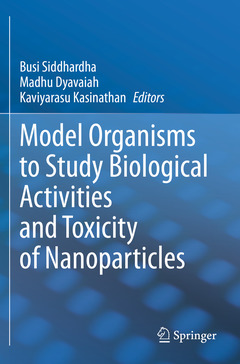Model Organisms to Study Biological Activities and Toxicity of Nanoparticles, 1st ed. 2020
Coordonnateurs : Siddhardha Busi, Dyavaiah Madhu, Kasinathan Kaviyarasu

This book provides a comprehensive overview of state-of-the-art applications of nanotechnology in biology and medicine, as well as model organisms that can help us understand the biological activity and associated toxicity of nanoparticles, and devise strategies to minimize toxicity and enhance therapies.
Thanks to their high surface-to-volume ratio, nanoparticles are characterized by excellent biocompatibility and bioavailability, a high therapeutic index, and relatively low toxicity, which has led to their widespread application in the early diagnosis of diseases, comprehensive monitoring of disease progression, and improved therapeutics.
The book also explores nanoparticle-based insecticides and their mechanisms of action, and provides a comparative analysis of the various model organisms that are used to understand the biological properties of nanoparticles. Further, it describes various in-vivo models that yield important insights into nanomaterial-mediated toxicity, promoting the optimal utilization of nanoparticles. In closing, the book discusses future perspectives and regulatory issues concerning the use of nanomaterials in translational research.
Dr. Busi Siddhardha is Assistant Professor in the Department of Microbiology, Pondicherry University, Puducherry, India. He has more than 12 years of research experience in the field of Microbiology, Antimicrobial drug discovery and Nanobiotechnology. He has worked for last 10 years on antimicrobial compounds and antimicrobial drug discovery. He worked at Biology Division, CSIR-IICT, Hyderabad, India for his PhD. He completed two research projects on antiquorum sensing and antibiofilm activities of natural products funded by Government of India. He is extensively working in the field of nanotechnology, especially applications of nanotechnology in drug discovery, drug delivery, sustained release and photodynamic therapy. Currently his group is working on Bacterial quorum sensing, Biofilms, Antimicrobial photodynamic therapy and nanobiotechnology. He is editorial board member of several reputed journals. He has also published more than 60 research articles in the peer-reviewedinternational journal and authored or co-authored numerous book chapters. He is a member of many national and international scientific societies. He has more than 7 years of teaching and research experience at the University level.
Dr. Madhu Dyavaiah is an Assistant Professor, in the Department of Biochemistry and Molecular Biology; Pondicherry University, Pondicherry. He has earlier served as Research Scientist in the College of Nanoscale Science and Engineering, Albany, USA (2010-2012), Postdoctoral associate at Gen’NY’sis Center for Excellence in Cancer Genomic Rensselaer, USA (2006-2010), Postdoctoral fellow at Wadsworth Center, USA (2003-2006) and IISc. Bangalore, India (2002-2003). His research interest includes, DNA damage response, tRNA modification and translation regulation and aging biology. He has worked in the area of nanotechnology in USA, and research experience different model systems including plant, S. cerevsiae, cell linesa
Date de parution : 03-2021
Ouvrage de 466 p.
15.5x23.5 cm
Date de parution : 03-2020
Ouvrage de 466 p.
15.5x23.5 cm
Disponible chez l'éditeur (délai d'approvisionnement : 15 jours).
Prix indicatif 105,49 €
Ajouter au panierThèmes de Model Organisms to Study Biological Activities and... :
Mots-clés :
Nanotechnology; Model organisms; Drug discovery; Biological activities; Toxicity



